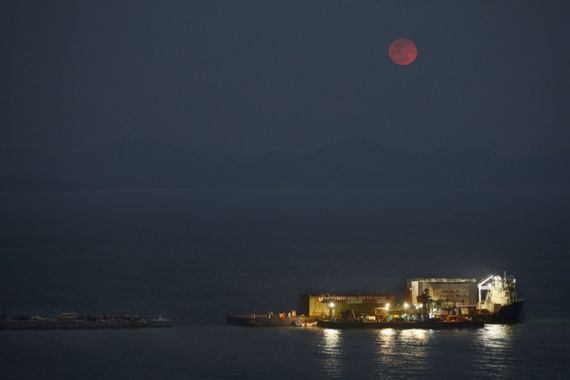Philippines seeks US help to counter China
The United States and the Philippines will hold combat drills together to counter China’s rising influence in the area.

 |
| China has behaved aggressively in the South China Sea, which is bordered by five other nations [GALLO/GETTY] |
Bangkok – The government of Philippines President Benigno Aquino may be wading into choppy diplomatic waters by turning to the United States to counter China’s aggressiveness in the South China Sea, one of the world’s busiest shipping lanes.
A protest outside the US embassy in Manila over the weekend by local leftwing and indigenous groups is an indication of what can be expected in the run-up to planned combat drills involving US and Filipino forces in the troubled waters of the South China Sea.
“The combat drills with US and Philippines marines have certainly worried many sectors here,” noted Walden Bello, a first-term congressman from the Citizens’ Action Party, which is part of the Aquino administration’s coalition in the national legislature.
“The Philippines is unfortunately playing a dangerous game in entertaining a US military presence,” he added in a telephone interview from Manila.
Giving Washington a military foothold will “convert a territorial dispute, where the Philippines has a stake, into a superpower conflict,” Bello said. “We should rely on regional and multilateral mechanisms.”
Nationalist response
A verbal volley fired by an ultra-nationalist Chinese newspaper brings such warnings into relief. The Philippines should be targeted with “countermeasures” and “punishment” for offering the US military an expanded role in the South China Sea, raged the English-language Global Times in a commentary last week.
“A reasonable yet powerful enough sanction can be considered,” added the paper. “It should show China’s neighbouring area that balancing China by siding with the US is not a good choice.”
|
Tensions rise between China and the Philippines |
The planned military drills off the Philippines coast, scheduled for late March or early April, will be staged near an oil rig in the South China Sea. This news, following a mid-January bilateral defence dialogue, came after the Philippines got another boost from US foreign policy heavyweights to contain China.
“What we’re talking about is maritime security,” US Senator Joseph Lieberman said at the end of a trip to the Philippines capital with three other senators last month. “We simply cannot allow one nation, in this case China, to exercise disproportionate control over these waterways.”
This body of water has increasingly become a flashpoint following China’s strident assertion in 2009 that it had control over a stretch of ocean that has a spread of reefs, coral atolls and slivers of land that are hardly habitable.
Yet, what has raised stakes in the South China Sea, whose waters are shared by Vietnam, Brunei, Malaysia, Taiwan and the Philippines, are reports that its bed contains huge deposits of oil and gas – in addition to supplying nearly one-tenth of the world’s seafood catch.
Energy issues
The Parcels Islands archipelago and the Spratly Islands have, consequently, become important for energy security.
China controls the Parcels, having edged out Vietnam in a 1974 battle that left 18 people dead. And, Manila fell victim to Beijing’s bullying when the Asian giant occupied the Mischief Reef in 1995, once part of the Philippines.
The dispute led to the 2002 Declaration on the Conduct of Parties in the South China Sea (DoC), the first political agreement between China and the Association of Southeast Asian Nations (ASEAN) bloc that includes Burma, Cambodia, Thailand, Singapore, Laos, Indonesia and South China Sea littorals – the Philippines, Vietnam, Brunei and Malaysia.
Neither the 10-year-old declaration, nor the diplomatic breakthrough in July last year to create “guidelines for implementing” the DoC, has done enough to ease the tension through 2011. Both Vietnam and the Philippines accused China of asserting its territorial claims by sending fleets of vessels into disputed areas.
“The Philippines has become the most outspoken on this issue with the ASEAN members,” says Kavi Chongkittavorn, a regional affairs commentator, in The Nation, an English daily in Thailand. “It has been boosted by the defence treaty it has with the US.”
But efforts by Manila to raise the diplomatic stakes against China “will not have wide support in ASEAN”, Kavi said. “ASEAN will not want to be dragged into a conflict with China.”
The imminent diplomatic challenge Manila faces comes nearly a year after the Philippines government turned to the United Nations Convention on the Law of the Sea (UNCLoS) to resolve its territorial disputes.
“The Philippines has called on ASEAN to support the idea that the issue must be resolved on the basis of the rule of law, particularly UNCLoS,” reveals Herman Kraft, associate professor of political science at the University of the Philippines.
“Using UNCLoS to advance its argument allows the Philippines to take the moral high ground and hopefully (win) the sympathy of the international public,” he explained in an interview. “(China’s push to resolve the problem bilaterally) is a non-starter for a small state dealing with a larger and more powerful state.”
There is an international treaty which can help “break the deadlock between China and other countries over territorial disputes in the South China Sea,” says Kumar Chitty, a former senior UN official at the International Tribunal for the Law of the Sea, a Hamburg-based judicial body created to resolve disputes between countries about the oceans and their resources. “This is how Australia and East Timor resolved their dispute,” Chitty said.
But China is avoiding such an international judicial route, preferring the ASEAN-led DoC resolution.
“China will seize this opportunity of making efforts with ASEAN countries to maintain peace and stability in the South China Sea and bring benefits to the people in the region,” Chinese foreign ministry spokesman Lu Weimin said following last month’s ministerial meeting in China to reduce tensions in the South China Sea.
A version of this article was first published on Inter Press Service.